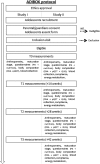Cross-sectional and longitudinal study protocols of the 'ADIposity and BOne metabolism: effects of eXercise-induced weight loss in obese adolescents' (ADIBOX) project
- PMID: 27797988
- PMCID: PMC5073595
- DOI: 10.1136/bmjopen-2016-011407
Cross-sectional and longitudinal study protocols of the 'ADIposity and BOne metabolism: effects of eXercise-induced weight loss in obese adolescents' (ADIBOX) project
Abstract
Introduction: A need exists for sustainable and clinically effective weight management interventions, suitable for preventing well-linked chronic disease such as diabetes and cardiovascular disease and some less investigated secondary conditions such as bone alteration. The ADIposity and BOne metabolism: effects of eXercise-induced weight loss in obese adolescents (ADIBOX) protocol was designed to provide a better understanding of the interaction between adipokines and bone hormones in adolescents with obesity and how a 10-month physical activity programme may affect these interactions.
Methods and analysis: The ADIBOX protocol combines 2 studies. The first study involves a total of 68 adolescents aged 12-16 years. This cross-sectional study will include both males and females (1:1 ratio), either living with obesity/overweight (n=34; body mass index (BMI) ≤97th centile and ≥85th centile) or normal weight (n=34; BMI<85th centile). The second study is a longitudinal study that will include 50 obese adolescent girls and track them over a period of 42 weeks. Weight loss programme will consist of a combination of physical activity and a normocaloric diet. Bone and adiposity-related measurements will be performed every 14 weeks. Both studies will assess participants' anthropometric profile, nutrition and physical activity, body composition, bone densitometry and blood markers of bone, growth and adiposity.
Ethics and dissemination: The ADIBOX protocol complies with the ethics guidelines for clinical research and has been approved by their respective ethics committee (Australian Catholic University Committee Ethic, Australia and Hospital Sud Est 1 committee, France). Findings from this protocol are expected to clarify the possible interactions between adiposity and bone in childhood obesity and will be disseminated at several research conferences and published articles in peer-reviewed journals.
Trial registration number: NCT02626273; Pre-results.
Keywords: adipocytes; adolescents; obesity; osteocytes; physical activity.
Published by the BMJ Publishing Group Limited. For permission to use (where not already granted under a licence) please go to http://www.bmj.com/company/products-services/rights-and-licensing/.
Conflict of interest statement
Conflicts of Interest: None declared.
Figures


Similar articles
-
Stress management in obesity during a thermal spa residential programme (ObesiStress): protocol for a randomised controlled trial study.BMJ Open. 2019 Dec 23;9(12):e027058. doi: 10.1136/bmjopen-2018-027058. BMJ Open. 2019. PMID: 31874865 Free PMC article.
-
The association among skeletal muscle phosphocreatine recovery, adiposity, and insulin resistance in children.Pediatr Obes. 2017 Apr;12(2):163-170. doi: 10.1111/ijpo.12123. Epub 2016 Feb 24. Pediatr Obes. 2017. PMID: 26916682
-
Geometric and Mechanical Bone Response to a Multidisciplinary Weight Loss Intervention in Adolescents With Obesity: The ADIBOX Study.J Clin Densitom. 2020 Apr-Jun;23(2):254-263. doi: 10.1016/j.jocd.2018.06.002. Epub 2018 Jun 19. J Clin Densitom. 2020. PMID: 30076009
-
Efficacy of Exercise Intervention for Weight Loss in Overweight and Obese Adolescents: Meta-Analysis and Implications.Sports Med. 2016 Nov;46(11):1737-1751. doi: 10.1007/s40279-016-0537-6. Sports Med. 2016. PMID: 27139723 Review.
-
The Bones of Children With Obesity.Front Endocrinol (Lausanne). 2020 Apr 24;11:200. doi: 10.3389/fendo.2020.00200. eCollection 2020. Front Endocrinol (Lausanne). 2020. PMID: 32390939 Free PMC article. Review.
Cited by
-
Bone Metabolism in Adolescents and Adults Undergoing Roux-En-Y Gastric Bypass: a Comparative Study.Obes Surg. 2019 Jul;29(7):2144-2150. doi: 10.1007/s11695-019-03797-5. Obes Surg. 2019. PMID: 30820885
References
MeSH terms
Associated data
LinkOut - more resources
Full Text Sources
Other Literature Sources
Medical
Research Materials
